The 1930s was a golden era of Hollywood glamour, where elegance met sophistication in every aspect of fashion, especially hairstyles.
If you’re captivated by vintage beauty and want to recreate the timeless charm of this iconic decade, you’ve come to the right place.
This comprehensive guide explores 30 Elegant 1930s Hairstyles for Long Hair You’ll Fall in Love With, offering you a treasure trove of styling inspiration that ranges from soft romantic waves to structured finger waves, victory rolls, and intricate updos.
Each hairstyle in this collection captures the essence of 1930s femininity while remaining perfectly adaptable for modern wear, whether you’re preparing for a themed event, wedding, photoshoot, or simply want to add vintage flair to your everyday look.
Throughout this article, you’ll discover detailed styling techniques, the history behind each look, and practical tips to help you achieve these stunning hairstyles with your long locks.
From the red carpet glamour of Jean Harlow and Greta Garbo to the sophisticated elegance of everyday 1930s women, these hairstyles represent a decade where beauty was an art form, and every curl told a story.
Contents
- 1 1. Classic Finger Waves
- 2 2. Deep Side Part with Waves
- 3 3. Marcel Waves
- 4 4. Victory Rolls
- 5 5. Low Chignon with Waves
- 6 6. Pageboy with Soft Curls
- 7 7. Pin Curl Set Waves
- 8 8. Gibson Tuck
- 9 9. Barrel Curls
- 10 10. Braided Crown
- 11 11. Side Swept Waves with Hair Clip
- 12 12. Rolled Updo
- 13 13. Half-Up Curled Style
- 14 14. Faux Bob with Waves
- 15 15. Spiral Curls with Side Part
- 16 16. Pompadour with Flowing Waves
- 17 17. Asymmetrical Wave Pattern
- 18 18. Soft Romantic Curls
- 19 19. Snood-Covered Waves
- 20 20. Double Roll Updo
- 21 21. Crimped Waves
- 22 22. Side Bun with Cascading Curls
- 23 23. Centre Part with Smooth Waves
- 24 24. Twisted Crown with Loose Curls
- 25 25. Hollywood Glam Waves
- 26 26. Rolled Fringe with Waves
- 27 27. Pin-Up Style Waves
- 28 28. Knotted Updo
- 29 29. S-Wave Pattern
- 30 30. Draped Waves with Pearl Accessories
- 31 Styling Tips for Authentic 1930s Looks
- 32 Adapting 1930s Styles for Modern Wear
- 33 Historical Context: Why These Styles Defined an Era
- 34 Hair Care for Vintage Styling
- 35 Celebrity Inspiration: 1930s Hair Icons
- 36 Tools and Accessories for Creating 1930s Hairstyles
- 37 Step-by-Step: Creating Basic Finger Waves
- 38 Common Mistakes to Avoid When Creating 1930s Hairstyles
- 39 1930s Hairstyles for Different Hair Textures
- 40 Maintaining Your 1930s Hairstyle Throughout the Day
- 41 Creating 1930s Hairstyles for Special Occasions
- 42 Budget-Friendly Vintage Styling
- 43 Teaching Others: Sharing 1930s Styling Skills
- 44 The Modern Revival of 1930s Hairstyles
- 45 Conclusion
1. Classic Finger Waves
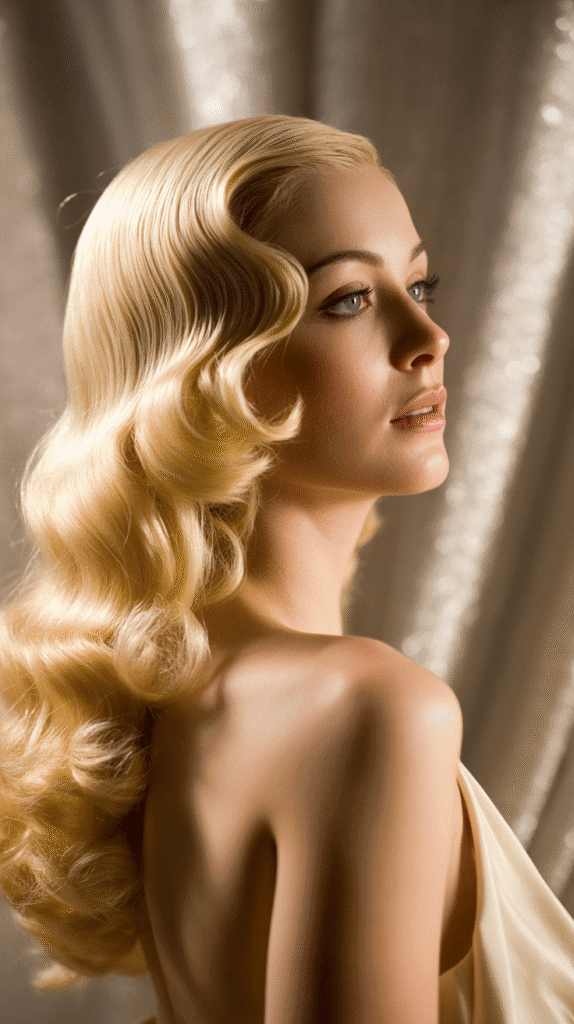
The finger wave is perhaps the most iconic hairstyle of the 1930s, representing the height of Art Deco elegance and sophistication.
This sculpted wave pattern was created using fingers, combs, and setting lotion to form S-shaped curves that lay flat against the head, creating a sleek and polished appearance that defined the era’s aesthetic.
- The technique originated in the 1920s but reached its peak popularity throughout the 1930s when women of all social classes embraced this elegant styling method.
- Creating authentic finger waves requires patience, strong-hold setting lotion, a fine-toothed comb, and wave clips to hold the pattern in place while drying.
- For long hair, finger waves typically covered the crown and sides of the head, while the length could be styled in various ways including rolls, curls, or left flowing.
- Modern adaptations often use curling irons or flat irons to create the wave pattern more quickly, though traditional methods produce more authentic results.
- This hairstyle works exceptionally well for formal events, vintage photoshoots, and weddings where a touch of old Hollywood glamour is desired.
2. Deep Side Part with Waves
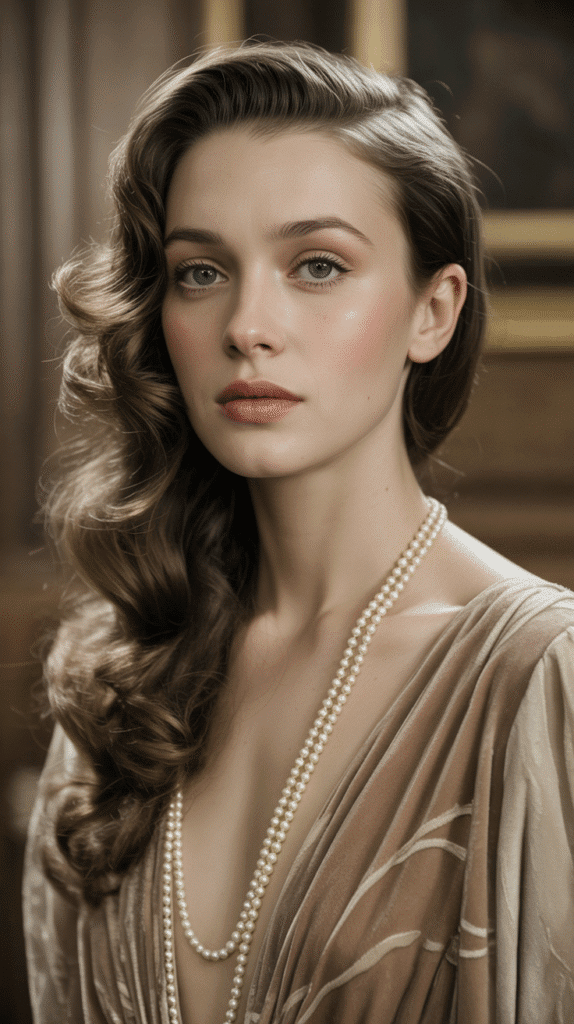
The deep side part became a defining feature of 1930s hairstyling, creating asymmetry and drama that perfectly complemented the decade’s fashion silhouettes.
This style emphasized one side of the face while creating volume and movement through cascading waves on the opposite side.
- Parting hair deeply on one side (usually about one to two inches from the center) instantly creates that authentic 1930s look.
- The heavier side typically featured soft, sculptured waves that swept across the forehead and down past the ears.
- Hair was often set in pin curls or rollers after creating the waves to add body and ensure the style lasted throughout the day.
- This versatile style could be dressed up with jeweled clips or combs for evening wear, or kept simple for daytime elegance.
- The deep side part works particularly well for oval and heart-shaped faces, as it creates balance and draws attention to the eyes.
3. Marcel Waves
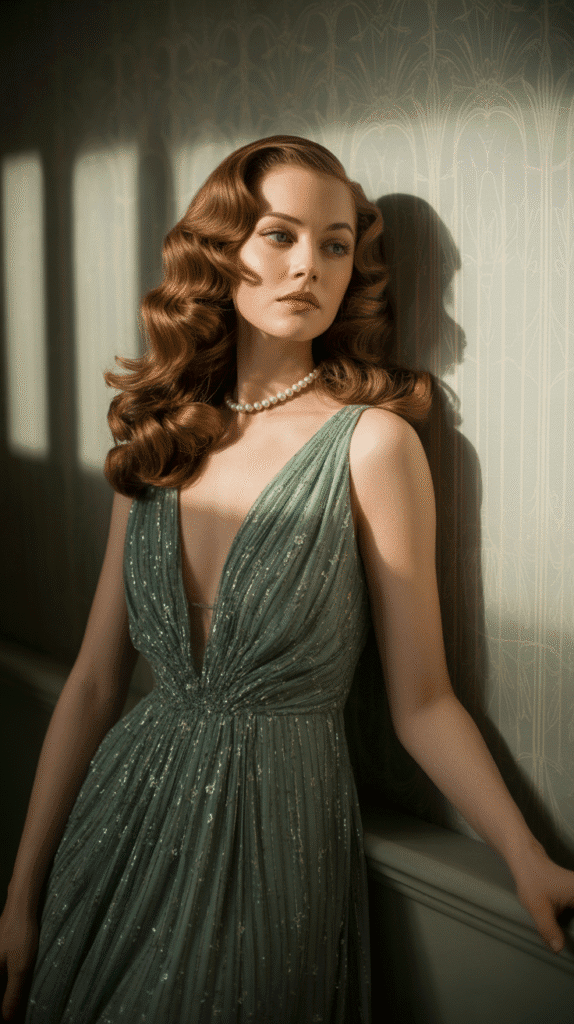
Marcel waves were named after French hairdresser Marcel Grateau, who invented the technique using heated curling irons to create deep, uniform waves.
This method produced more pronounced and longer-lasting waves than finger waves, making it extremely popular in the 1930s.
- The Marcel waving iron had a unique cylindrical design that allowed hairdressers to create precise, consistent wave patterns throughout the hair.
- Unlike finger waves that lay flat, Marcel waves had more dimension and body, creating a fuller silhouette.
- The technique required significant skill, as the iron temperature and placement had to be perfect to avoid damaging the hair while creating beautiful waves.
- For long hair, Marcel waves could be created from roots to ends, producing an all-over wavy texture that was both glamorous and natural-looking.
- Today’s styling tools like modern curling irons or waving irons can replicate this look with temperature controls for safer styling.
4. Victory Rolls
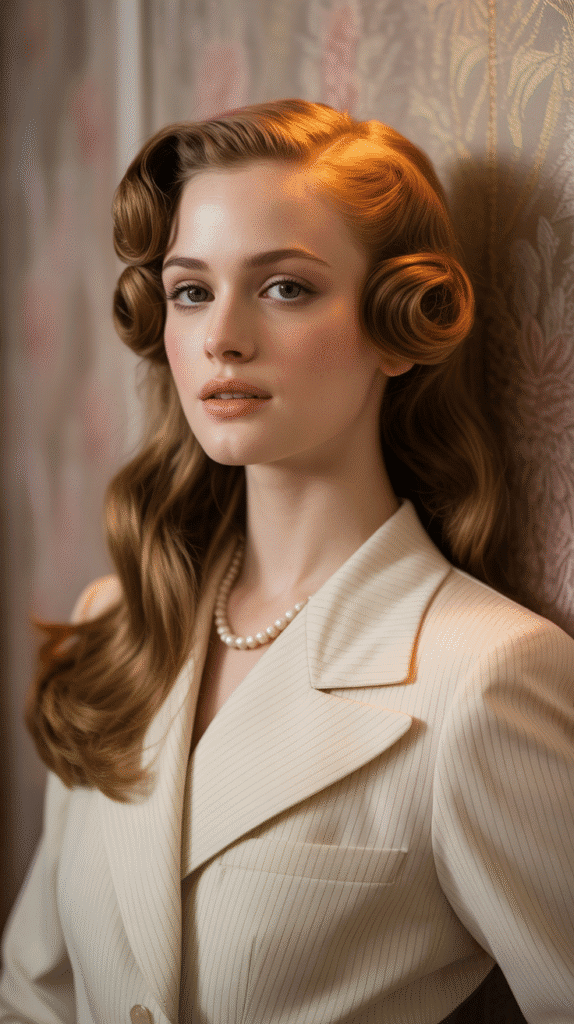
Though victory rolls became more prominent in the 1940s, their origins trace back to the late 1930s as an elegant updo variation.
This style featured sections of hair rolled upward and inward, creating distinctive tubular shapes that added height and sophistication.
- Early 1930s versions were typically smaller and more subtle than their 1940s counterparts, focusing on elegance rather than dramatic volume.
- The rolls could be created on one side, both sides, or even at the crown, depending on the desired level of formality.
- Long hair provided ample length to create substantial rolls that held their shape throughout the day without requiring excessive pinning.
- Setting lotion or pomade was essential for smoothing the hair and ensuring the rolls maintained their sleek appearance.
- This style transitioned beautifully from the refined elegance of the 1930s into the patriotic symbolism of the war years.
5. Low Chignon with Waves
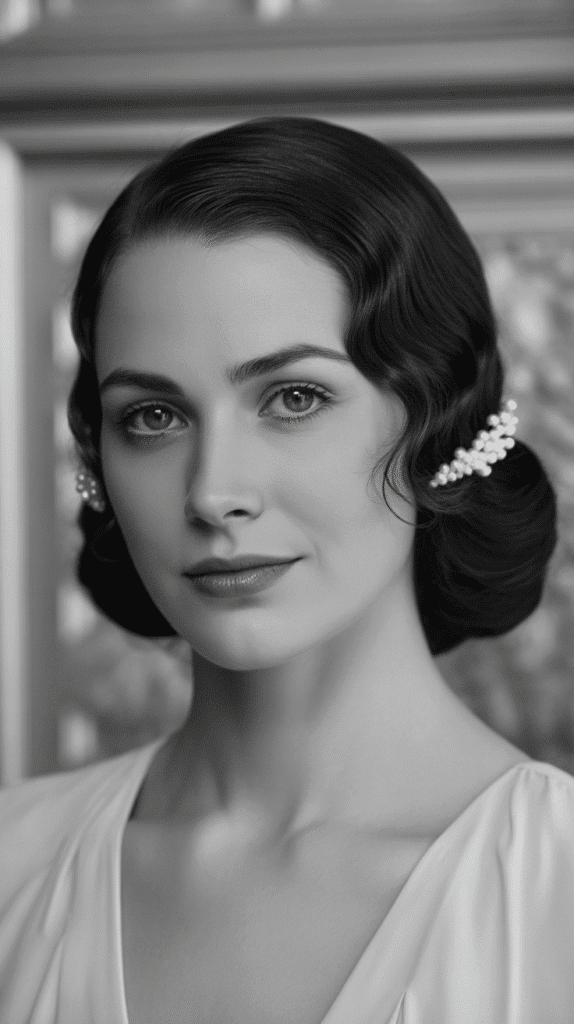
The low chignon represented understated elegance in 1930s hairstyling, combining the era’s signature waves with a practical yet sophisticated updo.
This style was particularly favored for daytime wear and professional settings.
- The style began with creating soft waves or curls throughout the hair, typically using pin curls or rollers set the night before.
- Hair was then gathered at the nape of the neck and twisted or rolled into a neat chignon, secured with pins and often covered with a hairnet for extra hold.
- The front sections maintained the wavy texture, often featuring a side part and soft waves framing the face.
- This versatile style could be adorned with decorative combs, clips, or left simple depending on the occasion.
- The low chignon was praised for its practicality as it kept long hair neat and tidy while still maintaining feminine appeal.
6. Pageboy with Soft Curls
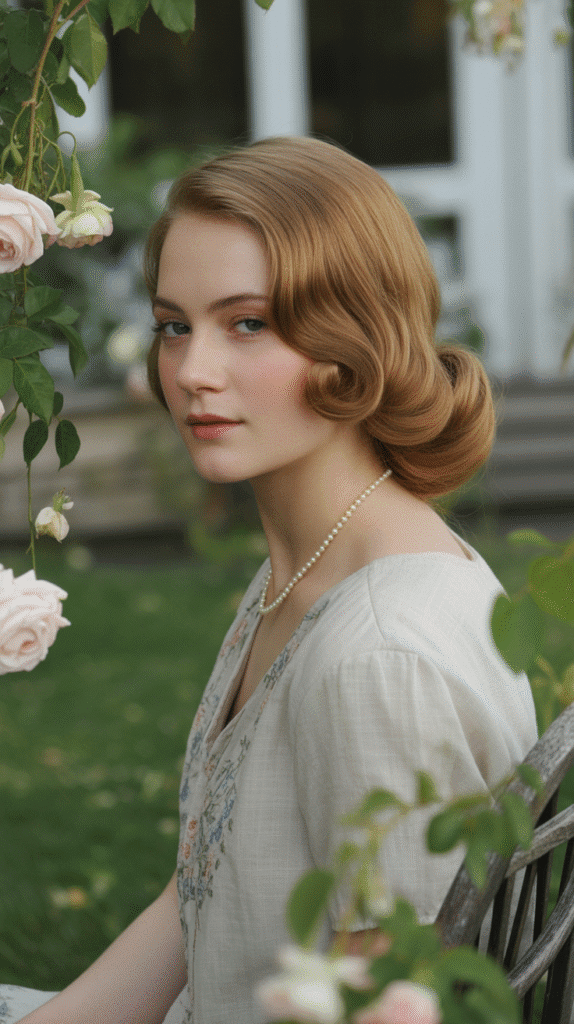
The pageboy emerged in the 1930s as a youthful and fresh alternative to more structured styles, featuring hair that turned under at the ends in a smooth, rounded shape.
When adapted for long hair, this created a romantic and feminine silhouette.
- The classic pageboy length ended at the shoulders, but longer versions extended past the shoulders with the ends still curling under uniformly.
- Achieving this look required setting hair in large rollers that curled under, creating that signature inward curve at the ends.
- The top and sides often featured subtle waves or were kept smooth, depending on personal preference and hair texture.
- This style was considered more casual and youthful than elaborate finger waves, making it popular for everyday wear.
- The pageboy’s simplicity made it accessible to women who styled their hair at home without professional assistance.
7. Pin Curl Set Waves
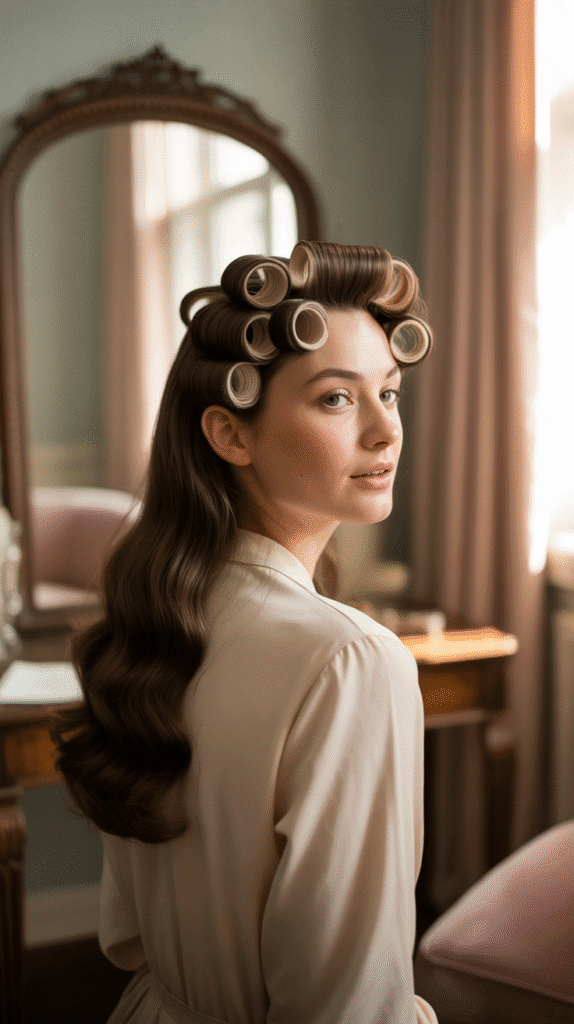
Pin curls were the foundation of many 1930s hairstyles, serving as the overnight setting method that created lasting waves and curls.
This technique was essential for achieving the smooth, uniform wave patterns characteristic of the era.
- Small sections of damp hair were wound flat against the scalp in circular patterns and secured with bobby pins or special pin curl clips.
- The direction and size of the pin curls determined the final wave pattern, with careful planning required to achieve the desired style.
- After drying completely (often overnight), the pins were removed and hair was gently brushed into soft waves or left as defined curls.
- Long hair could be set entirely in pin curls, creating an all-over wavy texture that had remarkable staying power.
- This method required no heat, making it gentler on hair than hot curling tools while still producing beautiful results.
8. Gibson Tuck
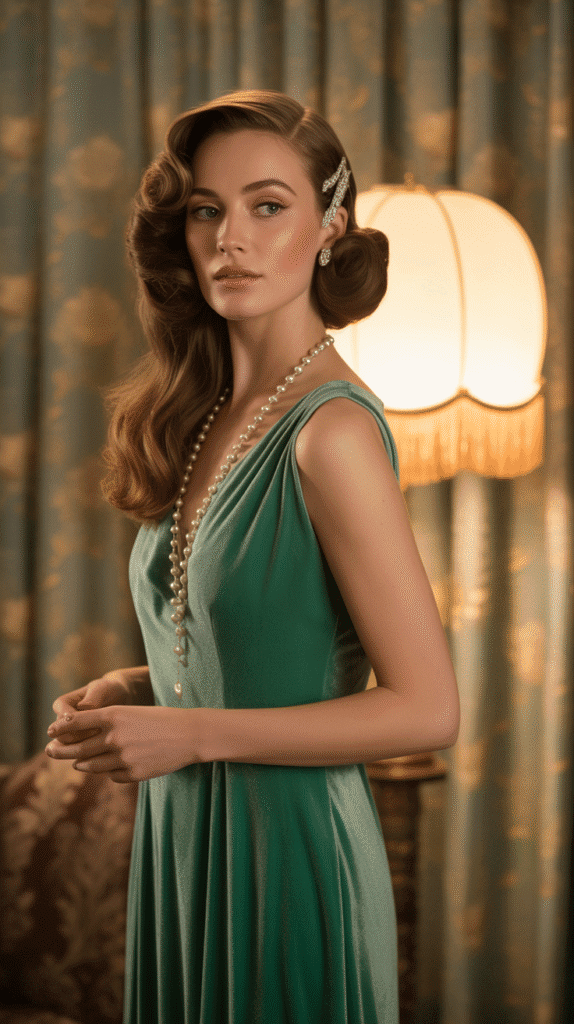
The Gibson Tuck, named after Gibson Girls of the earlier era, remained popular into the 1930s as an elegant updo option.
This style featured hair loosely gathered and tucked under at the nape, creating a soft, romantic silhouette.
- The technique involved gathering hair at the nape, rolling it upward and inward, then securing it with pins to create a horizontal roll.
- The front sections were typically styled with soft waves or left smooth, parted to the side in typical 1930s fashion.
- This style was particularly flattering for long, thick hair as it created a substantial, elegant shape at the back of the head.
- The Gibson Tuck could be worn low and tight for a sleek look, or loose and voluminous for a more romantic appearance.
- Decorative combs or hair ornaments were often placed at the crown or sides to add glamour for evening occasions.
9. Barrel Curls
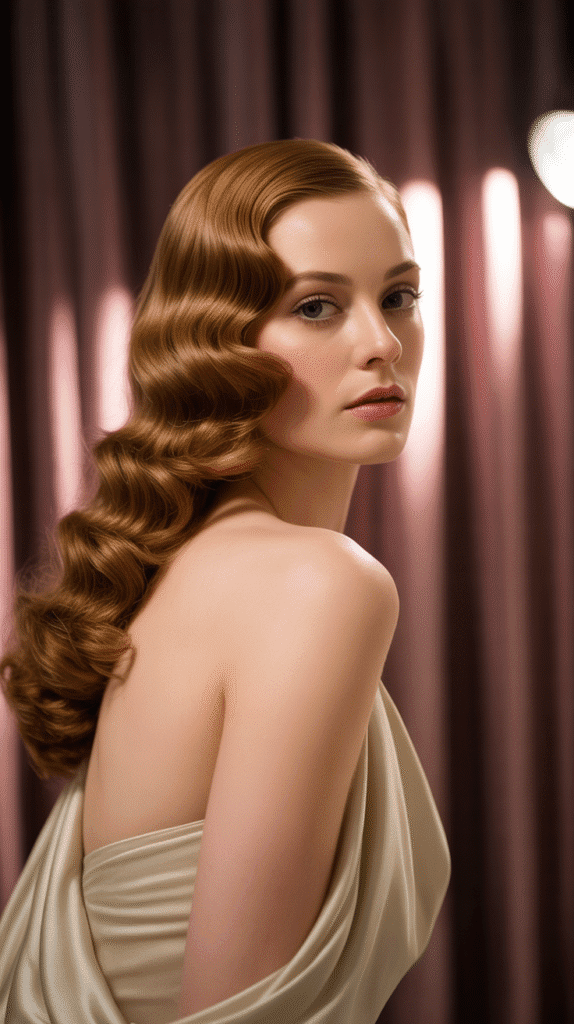
Barrel curls created cylindrical spirals of hair that added dimension and movement to 1930s hairstyles.
These large, smooth curls were distinct from the tighter ringlets of previous eras, reflecting the decade’s preference for sleek sophistication.
- Barrel curls were typically created using large rollers or by wrapping hair around a curling iron in a uniform direction.
- The curls were left intact rather than brushed out, maintaining their defined tubular shape for a polished appearance.
- For long hair, barrel curls could be arranged in various patterns, cascading over shoulders or pinned up in elaborate arrangements.
- This styling method worked particularly well for thick hair that could support the weight and shape of substantial curls.
- Evening styles often featured barrel curls combined with finger waves at the crown for a complete 1930s glamorous look.
10. Braided Crown
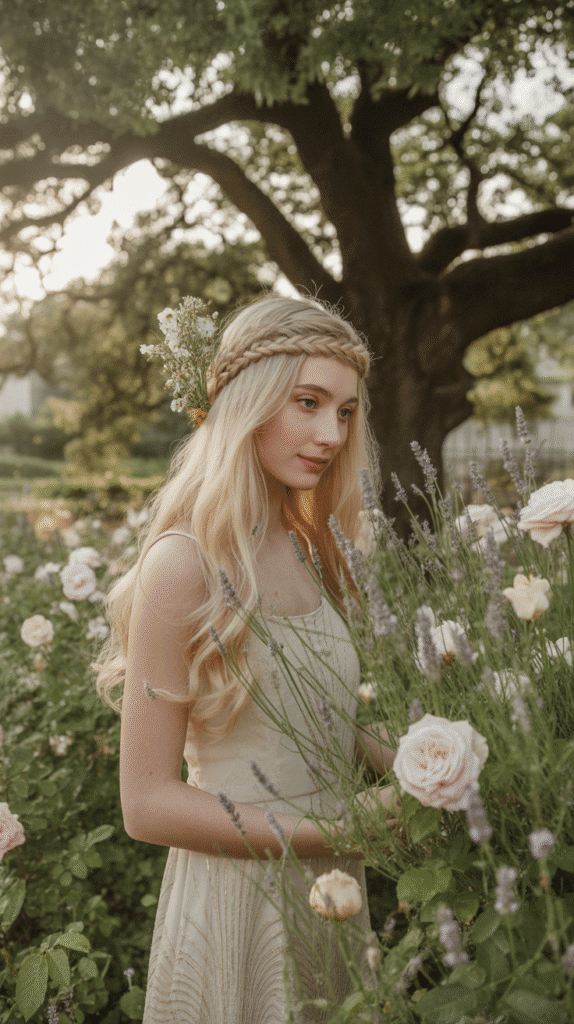
The braided crown offered a romantic alternative to the more common waved styles of the 1930s, incorporating traditional braiding techniques into contemporary styling.
This look was particularly popular for daytime and informal occasions.
- Hair was parted in the center or side, then sections from each side were braided and wrapped around the head like a crown or halo.
- The remaining length could be left down in waves, curled, or tucked under and pinned for a complete updo.
- This style had a softer, more natural quality than heavily structured finger waves, appealing to women seeking understated elegance.
- The braided crown was practical for active pursuits while still maintaining a feminine and polished appearance.
- Variations included single thick braids, multiple smaller braids, or incorporating twists along with braids for added texture.
11. Side Swept Waves with Hair Clip
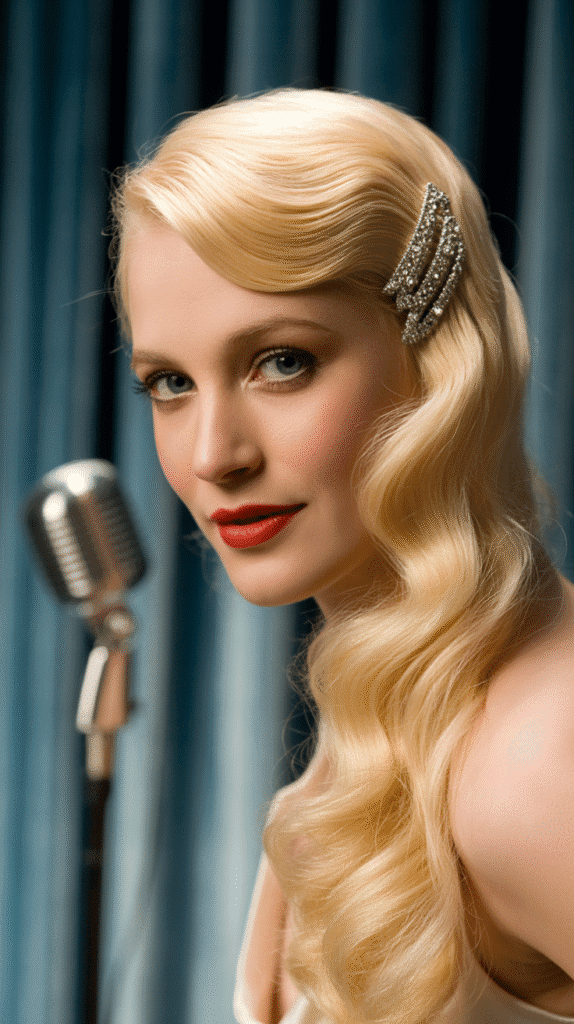
The side swept wave style epitomized 1930s glamour, featuring hair dramatically swept to one side and secured with an ornamental clip or comb.
This asymmetrical look was a favorite of film stars and fashion-forward women.
- Hair was styled in deep waves using finger wave or Marcel wave techniques, then swept dramatically across the forehead and over one ear.
- Decorative clips, often featuring Art Deco designs with rhinestones or geometric patterns, served both functional and aesthetic purposes.
- The heavy side created a curtain of waves, while the lighter side was typically pinned close to the head for dramatic contrast.
- This style showcased one side of the face while creating mystery and allure on the opposite side.
- Long hair allowed for particularly dramatic sweeps, with waves cascading over the shoulder for maximum impact.
12. Rolled Updo
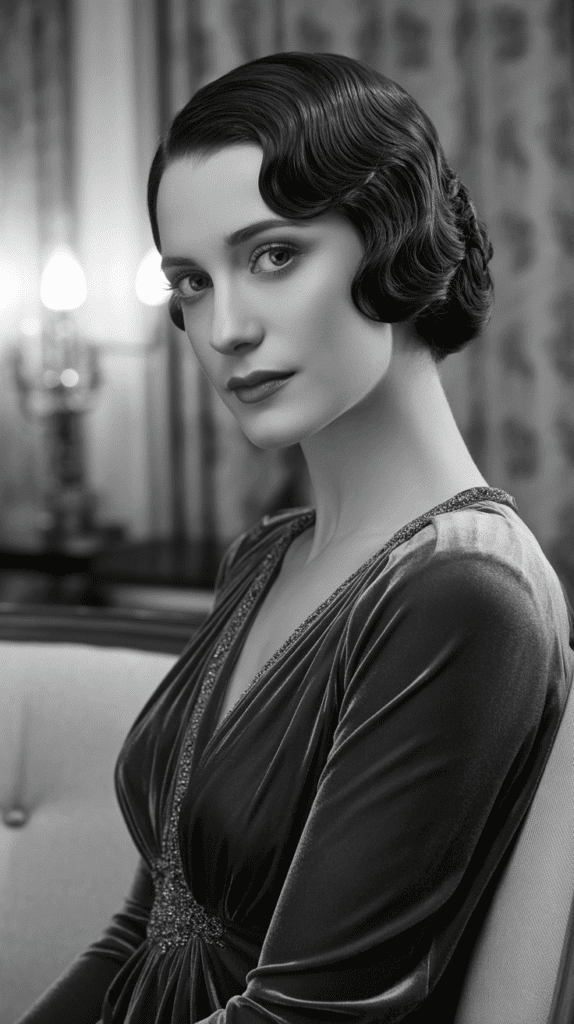
The rolled updo was a sophisticated styling option that involved rolling sections of hair upward and pinning them to create an elegant architectural shape.
This formal style was popular for evening events and special occasions.
- Hair was sectioned, with each section rolled upward (either toward the face or away from it) and secured with pins to create vertical or horizontal rolls.
- The rolls could be uniform in size or varied to create visual interest and dimension.
- Often combined with finger waves at the front for a complete 1930s aesthetic.
- This style required considerable skill and numerous pins to secure properly, making it a specialty of professional hairdressers.
- Long hair provided the length necessary to create substantial, impressive rolls that maintained their shape throughout an evening.
13. Half-Up Curled Style
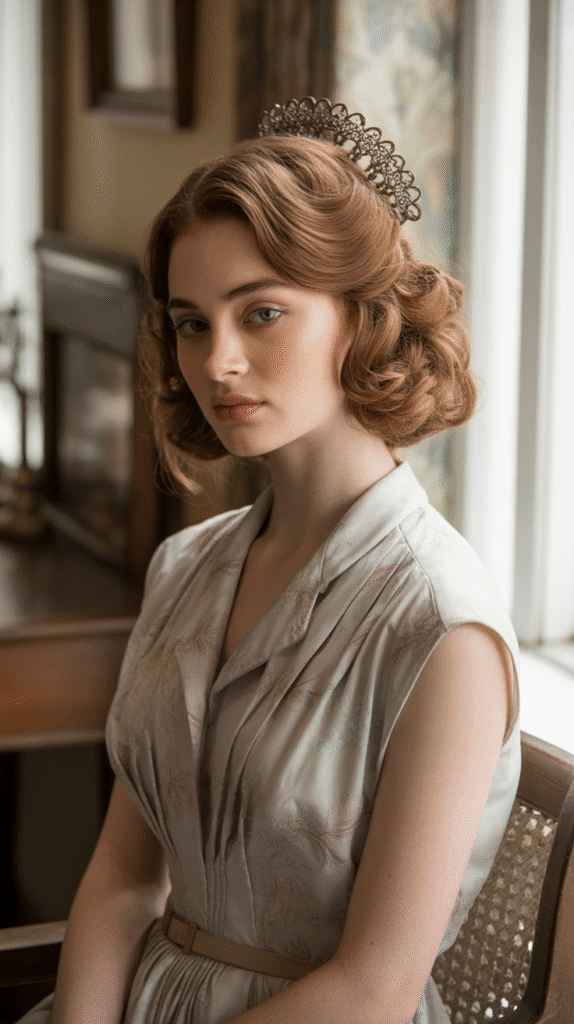
The half-up curled style offered a balance between wearing hair down and creating an updo, popular among younger women in the 1930s.
This versatile look combined the era’s styling techniques with a more casual, approachable aesthetic.
- The top and side sections were gathered and pinned at the crown or back of the head, often with decorative clips or combs.
- The upper sections typically featured waves or smooth styling, depending on the formality of the occasion.
- The lower portion was left down, styled in curls, waves, or even kept relatively straight for a sleeker look.
- This style was particularly practical as it kept hair out of the face while still showcasing length and styling.
- Variations included twisting the upper sections before pinning, creating small rolls, or incorporating braids.
14. Faux Bob with Waves
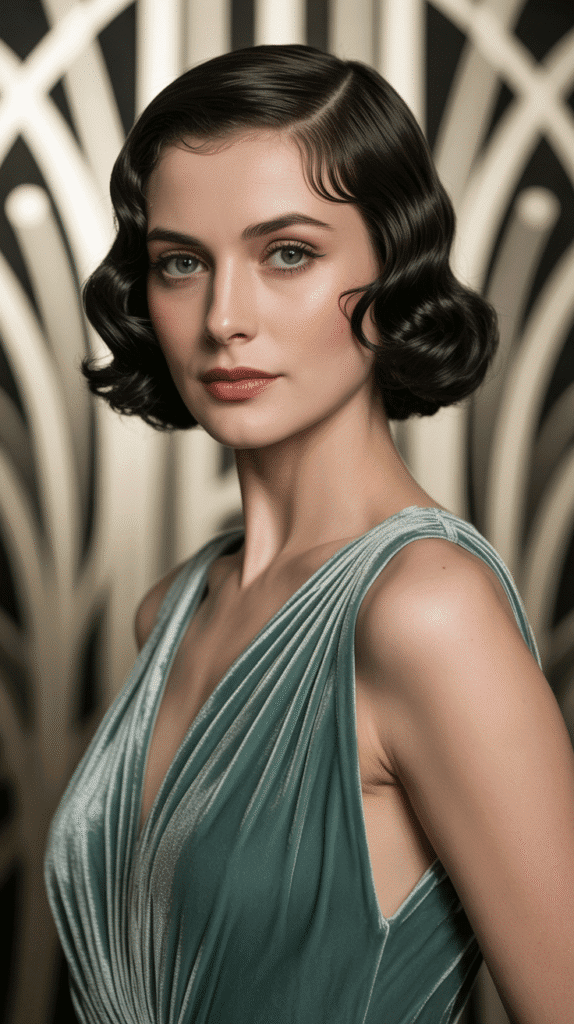
The faux bob allowed women with long hair to achieve the fashionable bobbed look without cutting their hair, representing a clever styling compromise.
This technique involved creating the illusion of shorter hair while keeping length hidden.
- Long hair was curled or waved at the ends, then folded under and pinned at approximately chin or shoulder length.
- The pinned sections were concealed beneath the upper layers, creating the appearance of a genuine bob.
- Finger waves at the crown and sides enhanced the authentic 1930s bob aesthetic.
- This style offered versatility, allowing women to change their look for different occasions without permanent commitment.
- Hairnets sometimes covered the pinned section to ensure smooth, undetectable tucking.
15. Spiral Curls with Side Part
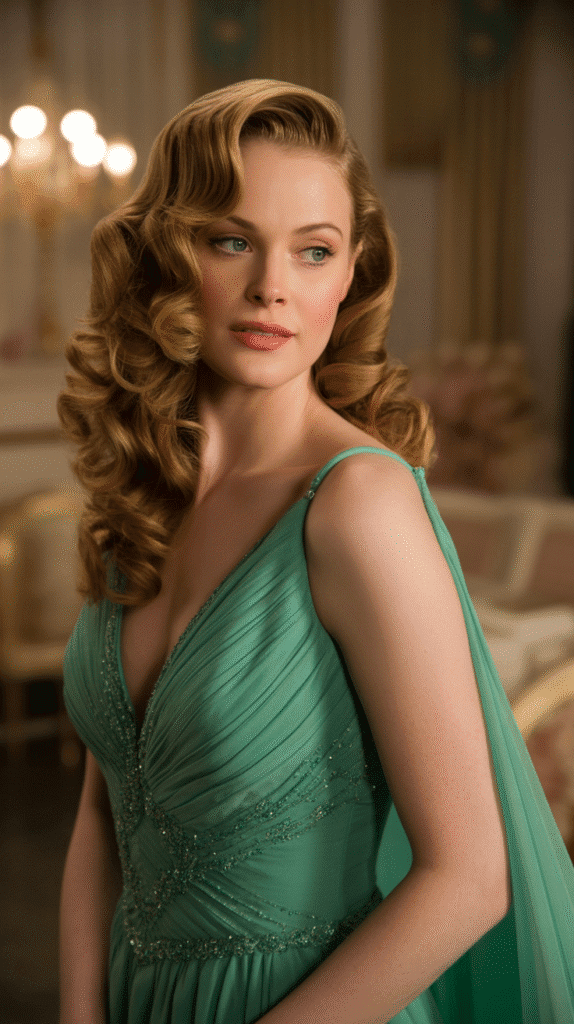
Spiral curls added vertical dimension to 1930s hairstyles, creating elongated ringlets that differed from horizontal waves.
When combined with the decade’s characteristic deep side part, this style achieved both structure and movement.
- Spirals were created by wrapping hair around curling irons or rollers vertically rather than horizontally.
- The curls maintained their cylindrical shape rather than being brushed into waves, creating defined columns of hair.
- A deep side part added the essential 1930s element, creating asymmetry and framing the face.
- For long hair, spiral curls could extend from mid-length to the ends, or cover the entire length for maximum impact.
- This style was particularly popular for evening wear and special occasions where more dramatic styling was appropriate.
16. Pompadour with Flowing Waves
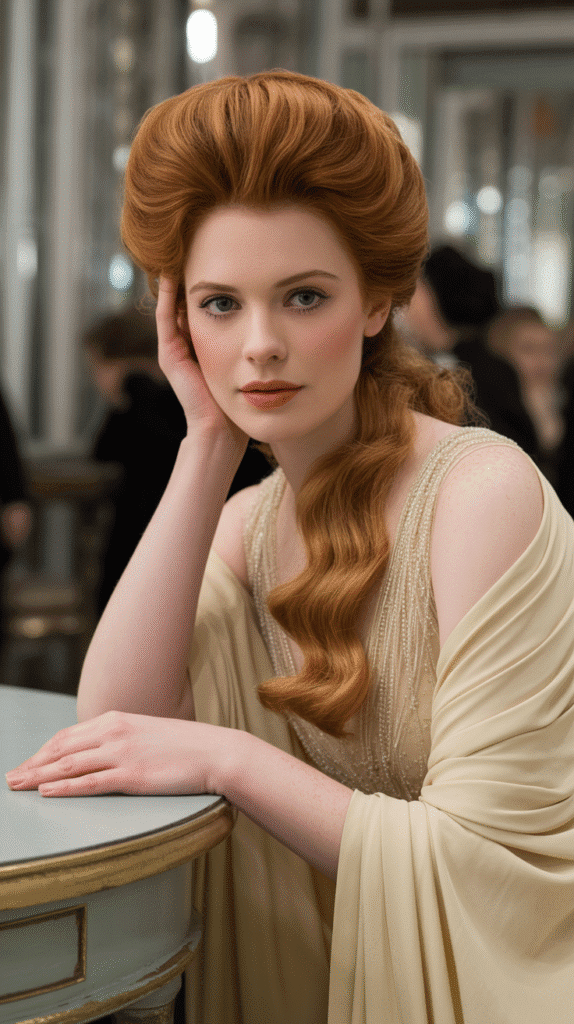
The pompadour style involved creating volume at the front of the head by rolling or sweeping hair upward and back, a technique that added height and drama.
Combined with flowing waves, this created a regal, sophisticated appearance.
- The front section of hair was backcombed, rolled, or swept upward to create a high, voluminous shape at the forehead.
- This front roll was carefully pinned to maintain its shape and height throughout wear.
- The remaining hair flowed back in soft waves, either left down or gathered into various updo arrangements.
- This style was associated with elegance and formality, often seen in formal portraits and evening events.
- Long hair provided the necessary length to create both the pompadour volume and maintain beautiful flowing sections.
17. Asymmetrical Wave Pattern
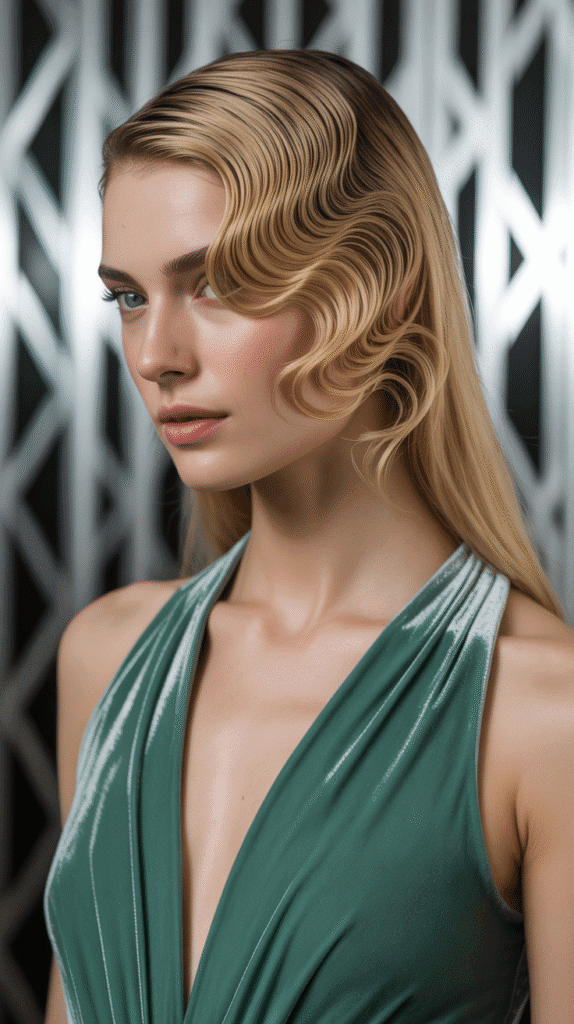
Asymmetrical styling was a hallmark of 1930s design across all art forms, and hairstyling was no exception.
This approach featured intentionally uneven wave patterns that created visual interest and artistic appeal.
- Waves on one side of the head were often deeper or more numerous than on the other side.
- The asymmetry was carefully planned to create balance while maintaining the intentional unevenness.
- This style showcased the artistry of hairstyling, demonstrating that waves were sculpted rather than simply curled.
- Long hair allowed for extended asymmetrical patterns that could flow down one shoulder more heavily than the other.
- This approach was particularly popular among fashion-forward women who embraced Art Deco aesthetics in all aspects of their appearance.
18. Soft Romantic Curls
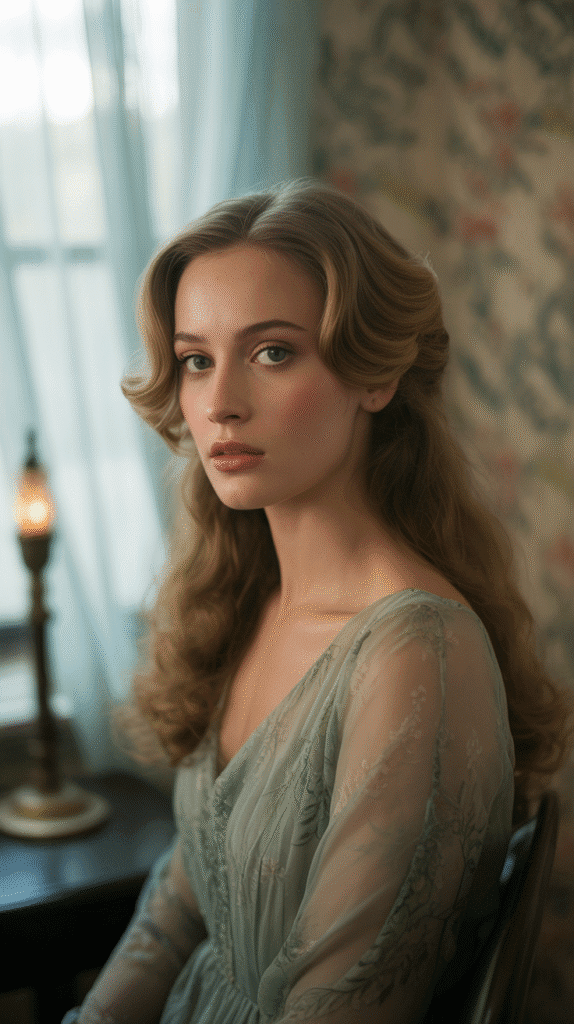
While structured waves dominated 1930s styling, soft romantic curls offered a gentler alternative that emphasized femininity and natural beauty.
This approach created a more relaxed interpretation of the decade’s aesthetic.
- Hair was curled throughout using rollers or curling methods, then gently brushed to soften the curls into flowing waves.
- The result was less structured than finger waves but still maintained the period’s characteristic smoothness and polish.
- This style was particularly flattering for women with naturally wavy or curly hair who wanted to embrace 1930s fashion without fighting their hair’s texture.
- Soft curls worked beautifully for both casual daytime looks and romantic evening styling.
- The approach required less maintenance than rigidly structured waves while still achieving vintage charm.
19. Snood-Covered Waves
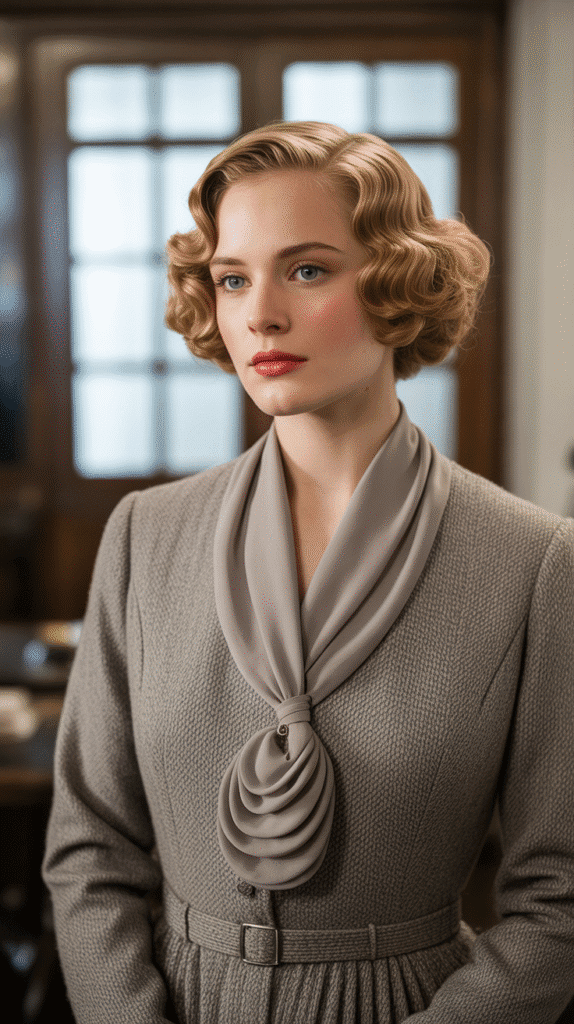
Snoods—decorative nets worn over hair—became increasingly popular in the late 1930s as both practical and stylish accessories.
When combined with waved styling, they created a distinctive vintage look.
- Hair was first styled in waves or curls, then gathered into a snood at the back of the head or nape of the neck.
- Snoods came in various materials including crochet, netting, or even silk for evening wear, often matching or coordinating with outfits.
- The front sections of hair were typically left exposed, showcasing finger waves or soft curls that framed the face.
- This combination of styling and accessory kept long hair neat and tidy while maintaining fashionable appearance.
- Snoods became especially practical as the decade progressed and women increasingly entered the workforce.
20. Double Roll Updo
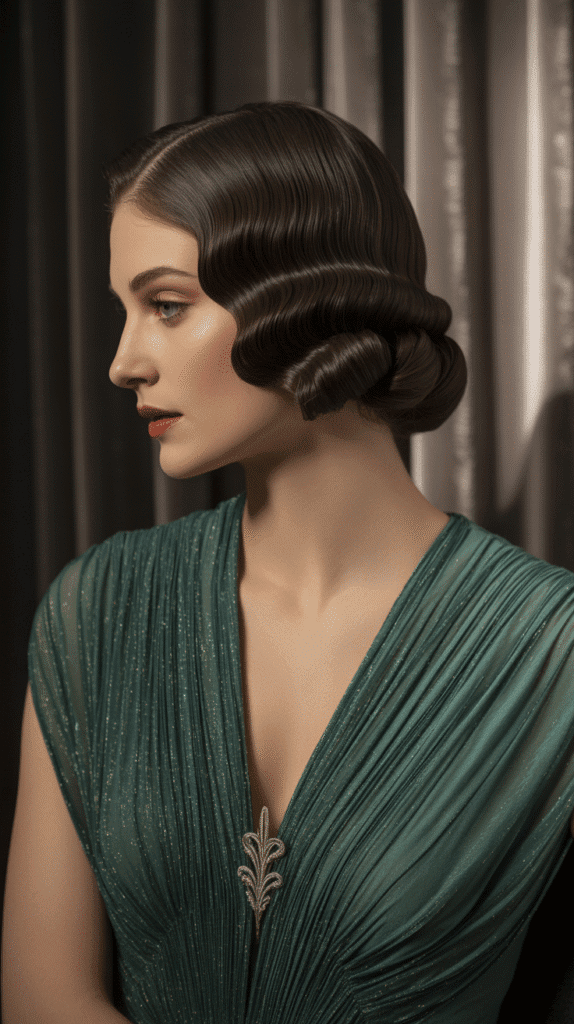
The double roll updo created an impressive architectural hairstyle by rolling hair in two distinct sections, typically one at the crown and another at the nape.
This formal style was reserved for special occasions and evening wear.
- Hair was divided horizontally, with the upper section rolled toward the face or crown and the lower section rolled at the nape.
- Each roll was substantial and carefully shaped, requiring significant pinning to secure.
- The front hairline often featured finger waves that connected seamlessly to the rolled sections.
- This style required professional expertise or considerable practice to execute properly.
- Long, thick hair was ideal for creating impressive, voluminous double rolls that made a statement.
21. Crimped Waves
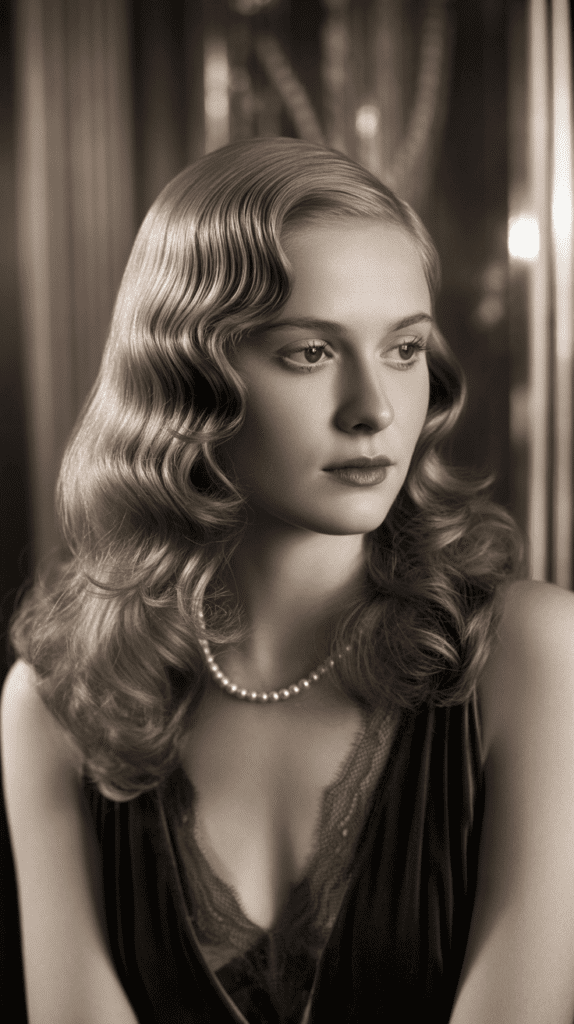
Crimped waves created a distinctive zigzag texture that added dimension and visual interest to 1930s hairstyles.
This technique produced waves with sharper definition than traditional finger waves or curls.
- Crimping irons with ridged surfaces created the characteristic zigzag pattern when clamped onto sections of hair.
- The texture could be subtle or dramatic depending on the size of the crimping tool and how the hair was styled afterward.
- Long hair showcased crimped texture beautifully, with the pattern extending from roots to ends for full impact.
- Crimped sections were sometimes combined with smooth or traditionally waved sections for contrast.
- This technique added volume to fine hair and created interesting texture for formal styling.
22. Side Bun with Cascading Curls
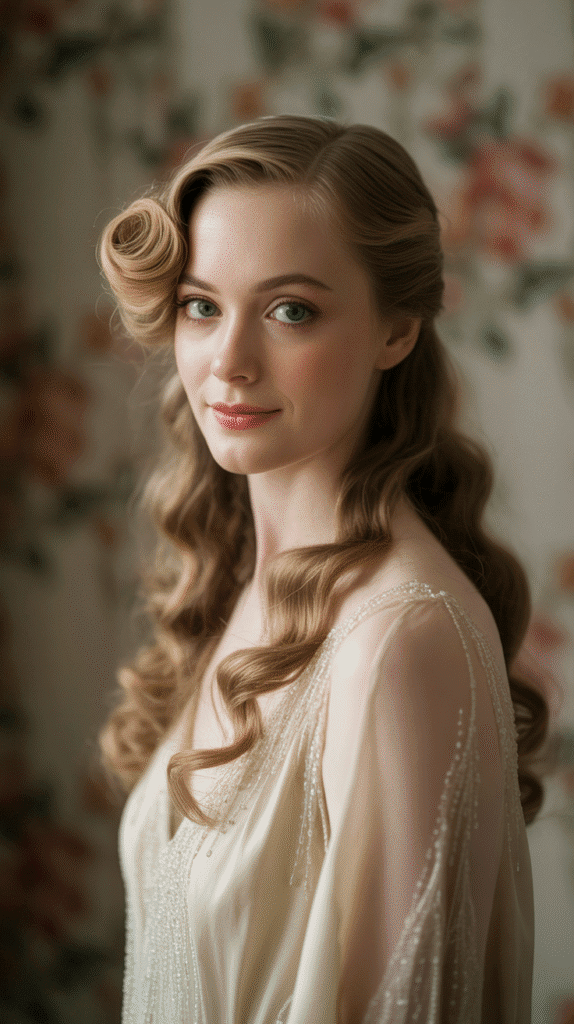
This elegant style combined the practicality of an updo with the glamour of flowing curls, creating a sophisticated yet romantic look.
A bun positioned at the side of the head anchored cascading curls for asymmetrical appeal.
- Hair was gathered to one side at approximately ear level, then twisted or rolled into a bun shape.
- Selected tendrils were left out and curled to cascade around the face and over the shoulder.
- The bun could be smooth and sleek or textured and voluminous depending on the desired level of formality.
- Decorative pins, combs, or flowers often adorned the bun for added elegance.
- This style was particularly popular for wedding and evening events in the 1930s.
23. Centre Part with Smooth Waves
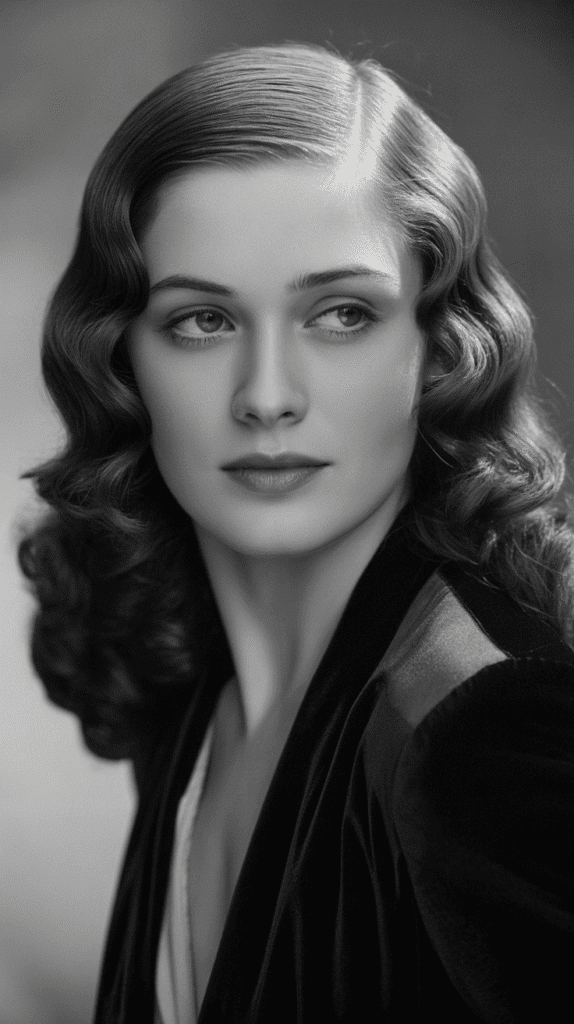
While deep side parts dominated 1930s styling, the centre part maintained popularity for creating a more classical, symmetrical look.
This style emphasized balance and proportion with matching waves on both sides.
- Hair was parted precisely down the center, creating perfect symmetry in the styling.
- Waves were created identically on both sides, flowing from the part toward the ears and down.
- This approach was considered more conservative and traditional than the dramatic side part styles.
- The symmetry created a softer, more approachable appearance suitable for daytime and professional settings.
- Long hair allowed the symmetrical wave pattern to continue down past the shoulders for full vintage effect.
24. Twisted Crown with Loose Curls
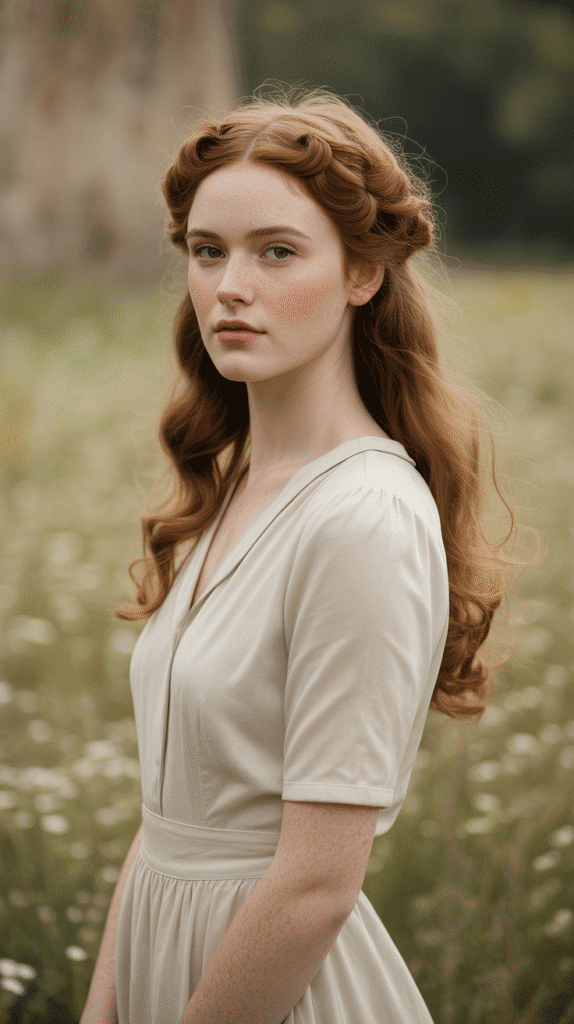
The twisted crown style incorporated rope-like twists around the hairline, creating a frame for the face while leaving the length in loose curls.
This combination balanced structure with softness.
- Front sections of hair were twisted backward from the face, either meeting at the center back or continuing around the entire hairline.
- The twists created a crown-like effect that added height and interest to the top of the head.
- Remaining hair was left down in loose curls or waves, providing movement and femininity.
- This style was relatively quick to create compared to elaborate finger waves, making it practical for everyday wear.
- Variations included incorporating small braids within or alongside the twists for added texture.
25. Hollywood Glam Waves
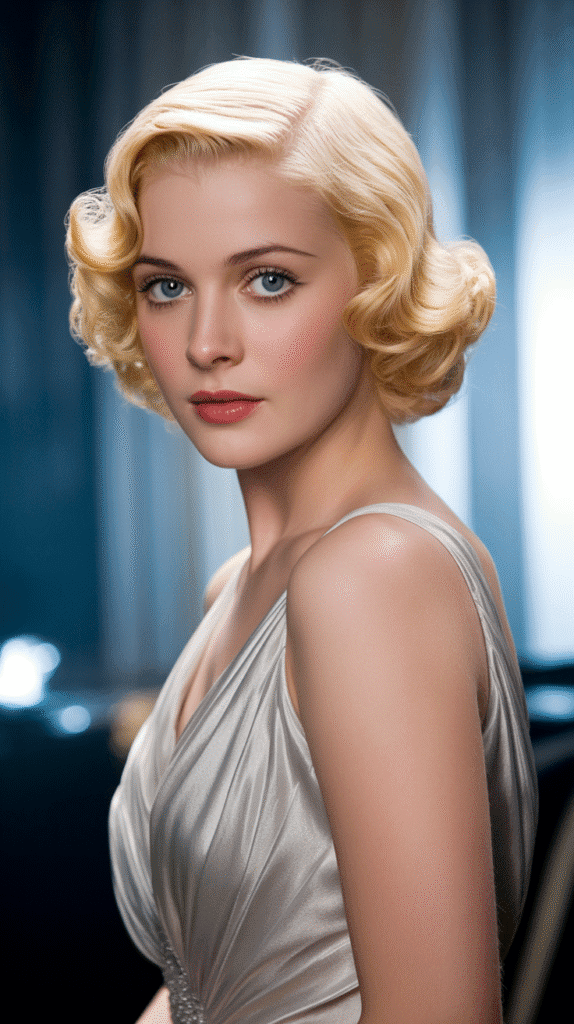
Hollywood glam waves represented the pinnacle of 1930s hairstyling sophistication, as seen on silver screen goddesses.
This ultra-polished look combined perfect finger waves with luxurious length and shine.
- Every wave was precisely sculpted and uniform, creating a flawless, mirror-like surface.
- Hair was typically very glossy, achieved through pomades and shine products that caught studio lighting.
- The styling was immaculate from every angle, as befitting its origins in film where 360-degree perfection was necessary.
- This level of styling typically required professional expertise and significant time investment.
- Long hair added to the dramatic effect, with waves continuing down past shoulders in perfectly controlled patterns.
26. Rolled Fringe with Waves
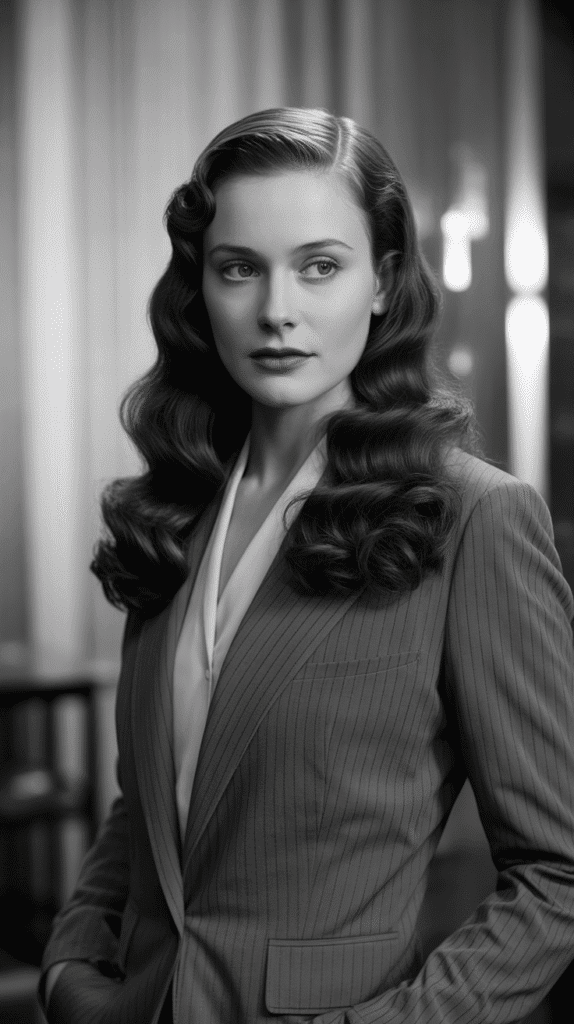
The rolled fringe (or bangs) style involved rolling the front section of hair upward and back, creating a small vertical roll at the hairline.
Combined with waves in the remaining hair, this created a distinctive 1930s look.
- The fringe section was rolled upward away from the face, then pinned to create a small tubular shape.
- This roll added height at the forehead and drew attention to the eyes.
- The sides and back were typically styled in waves that complemented the rolled fringe.
- This style was particularly popular among working women as it kept hair completely off the face while maintaining fashion.
- The rolled fringe could be small and subtle or large and dramatic depending on personal preference.
27. Pin-Up Style Waves
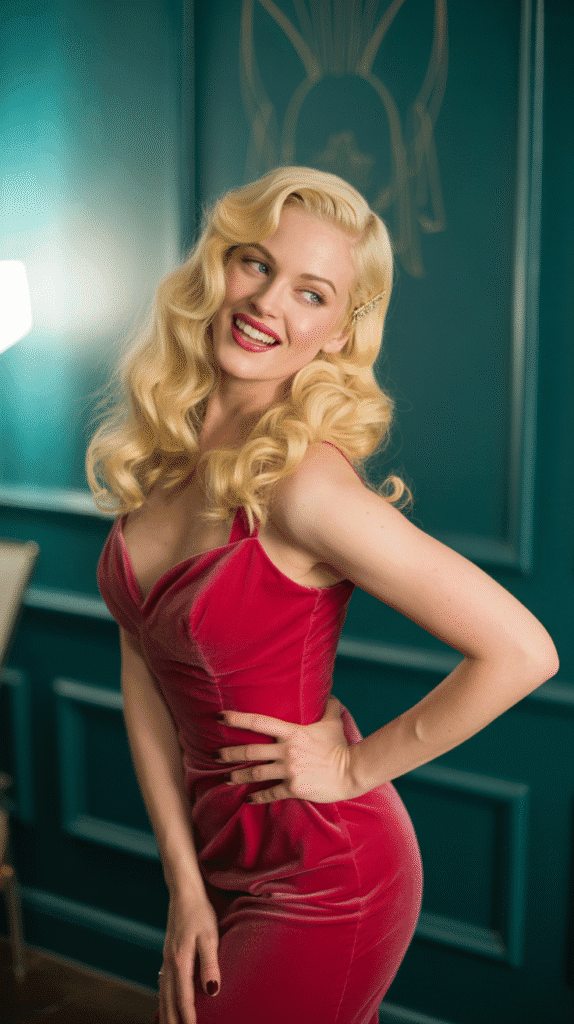
While pin-up styling is most associated with the 1940s, its foundations were laid in the late 1930s with glamorous waves and curls that emphasized curves and femininity.
This style was more playful than formal finger waves.
- Hair was styled in voluminous waves and curls that created fullness and movement.
- The approach emphasized sex appeal and confidence rather than refined sophistication.
- One side was often swept dramatically forward or to the side, creating that characteristic pin-up pose-ready look.
- Colors were often enhanced to vibrant platinum blonde, deep red, or jet black for maximum impact.
- This styling bridged the gap between 1930s elegance and the bolder aesthetics that would dominate the following decade.
28. Knotted Updo
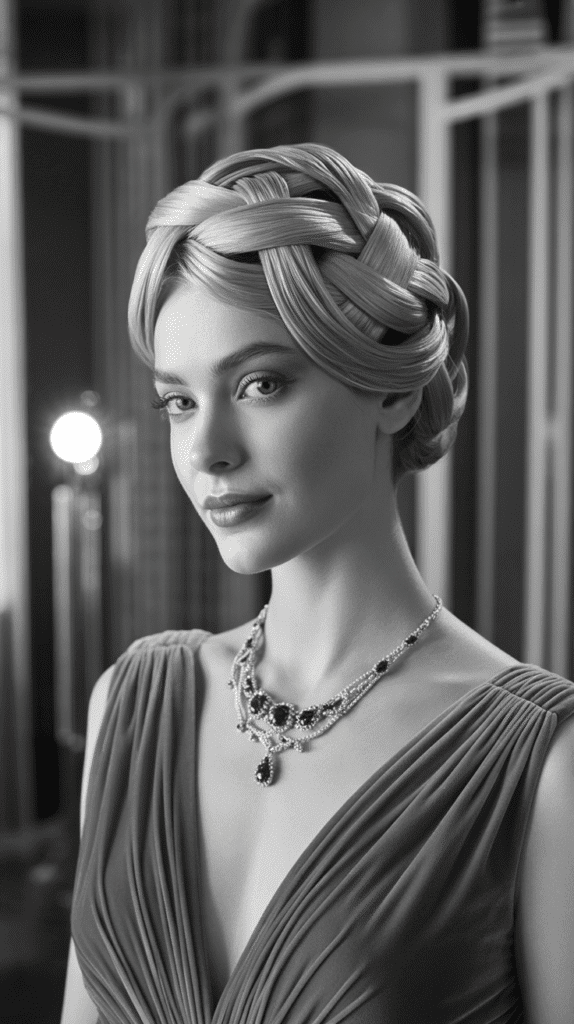
The knotted updo involved twisting and knotting sections of hair to create an intricate architectural style.
This sophisticated approach showcased the hairdresser’s artistry and was reserved for formal occasions.
- Multiple sections of hair were twisted individually, then tied into knots and arranged around the head.
- The knots could be small and numerous or larger and more dramatic depending on the design.
- This technique was particularly effective with long hair, as it provided ample length for creating impressive knots.
- The front was typically styled smooth or with subtle waves to balance the textured updo.
- Decorative pins or jeweled accessories were often incorporated into the knots for evening wear.
29. S-Wave Pattern
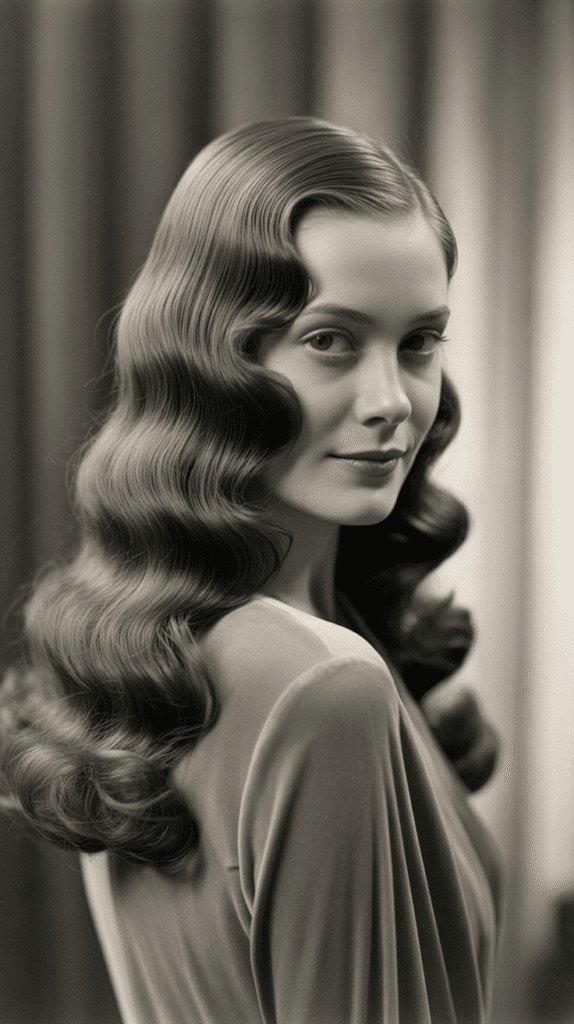
The S-wave pattern created continuous, uniform S-shaped curves throughout the hair, representing pure 1930s styling at its most characteristic.
This technique required precision and patience to execute properly.
- Hair was set in alternating directions to create connected S-shapes that flowed from roots to ends.
- Each curve needed to be identical in size and shape for the pattern to appear cohesive and polished.
- This all-over wave pattern worked beautifully on long hair, creating movement and visual interest at every length.
- The S-wave was typically set when hair was damp, using setting lotion and clips to hold the pattern until completely dry.
- Once dry, the waves maintained their shape remarkably well, often lasting several days with proper care.
30. Draped Waves with Pearl Accessories
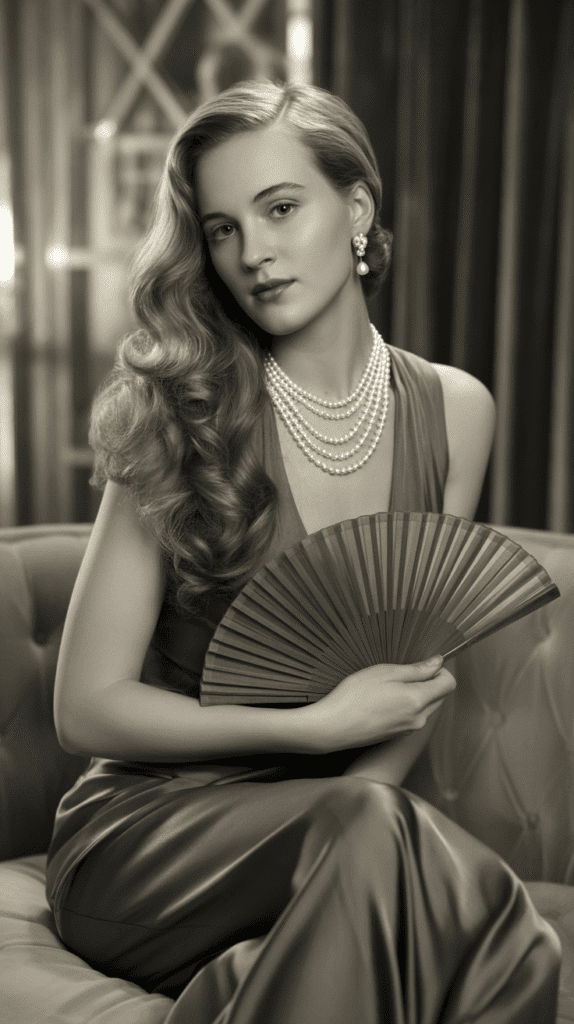
This luxurious style combined soft, draped waves with the decade’s love for pearl accessories, creating the ultimate in 1930s evening elegance.
The waves appeared to flow like liquid silk, enhanced by luminous pearl decorations.
- Hair was styled in loose, flowing waves that draped elegantly over shoulders and down the back.
- Pearl clips, combs, or strings of pearls were woven through or pinned into the waves at strategic points.
- The overall effect was one of refined luxury and old-money sophistication.
- This style was particularly popular for formal events, galas, and society occasions where displaying wealth and taste was expected.
- Long hair was essential for achieving the full draped effect that characterized this glamorous look.
Styling Tips for Authentic 1930s Looks
Achieving authentic 1930s hairstyles with modern tools and products requires understanding both historical techniques and contemporary adaptations. Here are essential tips to help you successfully recreate these vintage styles.
- Always start with clean hair and apply setting lotion or mousse for hold, as 1930s styles relied heavily on products to maintain their shape.
- Modern heat protectants should be used when employing hot tools, even though they weren’t available in the 1930s, to preserve your hair’s health.
- Practice finger wave techniques on mannequin heads or when you have plenty of time, as the skill requires development and patience.
- Invest in vintage-appropriate accessories like wave clips, decorative combs, and hair nets to achieve more authentic results.
- Study photographs from the 1930s to understand the precise placement and pattern of waves, as subtleties in direction and depth define the era.
- Set your hair while damp for traditional methods, allowing it to dry completely (overnight if necessary) before styling.
- Use a fine-toothed comb for creating crisp partings and precise wave patterns that characterize 1930s styling.
- Don’t brush out curls and waves too much, as 1930s styles maintained more definition than modern loose waves.
- Consider the proportions of your face when choosing which 1930s style to attempt, as different looks flatter different features.
- Film yourself or take photos from multiple angles when practicing, as 1930s hairstyles were designed to look perfect from every viewpoint.
Adapting 1930s Styles for Modern Wear
While authentic 1930s hairstyles are perfect for vintage events and themed occasions, many elements can be adapted for contemporary everyday wear. Understanding how to modernize these styles makes them more accessible and practical.
- Soften the rigid structure of finger waves by creating looser, more relaxed wave patterns that suggest the 1930s without full commitment.
- Incorporate single elements like a side sweep or decorative clip into otherwise modern hairstyles for subtle vintage flair.
- Use the deep side part with contemporary beach waves or air-dried texture for an updated take on 1930s asymmetry.
Historical Context: Why These Styles Defined an Era
Understanding the cultural and social context of 1930s hairstyles helps appreciate why these particular aesthetics dominated the decade. The Great Depression, Hollywood’s golden age, and evolving women’s roles all influenced hair fashion.
- The economic hardship of the Depression paradoxically created demand for glamorous, escapist beauty as women sought affordable luxuries through hairstyling.
- Hollywood cinema became the primary style influence, with movie stars like Jean Harlow, Greta Garbo, and Joan Crawford setting trends that ordinary women eagerly copied.
- The rise of home permanent wave kits democratized curly styling, making elaborate waves accessible to women who couldn’t afford regular salon visits.
- Art Deco design principles emphasizing geometric patterns, symmetry, and streamlined elegance directly translated to hairstyling aesthetics.
- Women’s increasing workforce participation created demand for styles that were both fashionable and practical enough to last through working hours.
- The decade’s emphasis on feminine sophistication represented a shift from the boyish flapper aesthetic of the 1920s to more traditionally glamorous ideals.
- Technological advances in hairstyling tools, including improved curling irons and chemical treatments, enabled more elaborate and longer-lasting styles.
- The decline of hat-wearing as mandatory fashion freed hairstyles to become the primary focus of head ornamentation and personal expression.
- Social etiquette still dictated that “respectable” women maintain polished appearances, making elaborate hairstyling a marker of social status and morality.
- The era’s slower pace of life allowed time for the lengthy styling sessions these intricate hairstyles required.
Hair Care for Vintage Styling
Maintaining healthy hair while frequently creating elaborate 1930s styles requires proper care and protection. Modern understanding of hair health can be combined with vintage aesthetics for the best results.
- Deep condition regularly to counteract the drying effects of setting products and heat styling tools used to create vintage waves.
- Allow hair adequate rest between elaborate styling sessions, wearing simpler styles or protective updos to prevent damage accumulation.
- Trim ends every six to eight weeks to maintain the healthy appearance essential for polished 1930s aesthetics.
- Use silk or satin pillowcases to preserve overnight sets and reduce friction that can damage styled hair.
- Apply heat protectant religiously before using any hot tools, even though this wasn’t available in the original era.
- Clarify hair monthly to remove product buildup from the heavy-hold setting lotions and pomades vintage styling requires.
- Massage scalp regularly to maintain healthy hair growth and circulation, especially when wearing tight updos or heavily pinned styles.
- Stay hydrated and maintain proper nutrition to support hair health from the inside, as elaborate styles look best on strong, healthy hair.
- Consider hair masks with protein treatments if you frequently manipulate your hair into intricate vintage arrangements.
- Remove all pins and accessories gently to avoid pulling and breakage, taking time to dismantle elaborate styles carefully.
Celebrity Inspiration: 1930s Hair Icons
The silver screen goddesses of the 1930s remain the ultimate inspiration for anyone seeking to recreate the era’s hairstyles. Understanding these icons’ signature looks provides valuable styling direction.
Jean Harlow revolutionized platinum blonde hair, wearing it in soft, glamorous waves that became her trademark and sparked a peroxide revolution across America.
Greta Garbo’s mysterious elegance was enhanced by her sleek, sophisticated waves that could transition from dramatic side-swept styles to more conservative center-parted looks.
Joan Crawford favored strong, architectural styles with pronounced waves and dramatic side parts that complemented her powerful on-screen persona.
Marlene Dietrich brought European sophistication to Hollywood with her perfectly sculpted waves and preference for asymmetrical styling that emphasized her striking features.
Carole Lombard embodied American glamour with her platinum waves and romantic styling that balanced sophistication with approachability.
Katharine Hepburn occasionally bucked trends with more natural, loosely waved styles that suggested independence and modernity.
Mae West wore elaborate updos and curls that matched her bombshell persona, often incorporating decorative elements and maximum volume.
Claudette Colbert popularized the sleek, close-to-the-head finger wave style that emphasized her gamine features and elegant bone structure.
Norma Shearer favored romantic, softer waves that created a more traditional feminine aesthetic perfect for her dramatic roles.
Bette Davis experimented with various 1930s styles throughout the decade, from tight finger waves to looser, more relaxed interpretations.
Tools and Accessories for Creating 1930s Hairstyles
Having the right tools makes recreating authentic 1930s hairstyles significantly easier and more successful. While some period tools are no longer manufactured, modern alternatives can achieve similar results.
Essential Modern Tools:
- Marcel curling iron or modern curling iron with clamp for creating uniform waves throughout the hair length.
- Fine-toothed rattail comb for precise parting and creating clean wave ridges in finger wave techniques.
- Paddle brush for smoothing sections and gently brushing out curls into softer waves without creating frizz.
- Sectioning clips to divide hair into manageable portions during the styling process and keep completed sections separated.
- Bobby pins in colors matching your hair shade for invisible securing of updos and pinned elements.
- Hair elastics in neutral tones for creating foundation ponytails or buns that serve as bases for elaborate styles.
- Teasing brush or comb for creating volume at the roots when needed for pompadours or rolled sections.
- Handheld mirror for checking all angles of your hairstyle, essential for achieving the 360-degree perfection of 1930s styling.
Vintage-Style Accessories:
- Wave clips (still manufactured) that hold the S-curve pattern of finger waves in place while hair dries completely.
- Decorative hair combs in Art Deco styles featuring geometric patterns, rhinestones, or faux pearls for authentic embellishment.
- Hair nets in various colors to invisibly secure updos and keep elaborate arrangements intact throughout wear.
- Vintage-inspired barrettes and clips that can function as both securing tools and decorative elements simultaneously.
- Headbands in period-appropriate styles, though these were less common in the 1930s than surrounding decades.
- Flowers (real or silk) for romantic styling, particularly popular for wedding and evening hairstyles of the era.
Step-by-Step: Creating Basic Finger Waves
Mastering finger waves is essential for authentic 1930s styling, and while the technique requires practice, following a systematic approach makes it achievable. This foundational skill opens doors to countless vintage hairstyles.
Preparation Phase:
- Start with freshly washed, towel-dried hair that is damp but not dripping wet for optimal setting lotion absorption.
- Apply generous amounts of strong-hold setting lotion or mousse throughout hair, combing through to ensure even distribution.
- Part hair deeply to one side using a rattail comb, creating a clean, precise line that will define your style.
- Section hair into manageable portions using clips, typically starting with a front section from part to ear.
Creating the First Wave:
- Place your index finger flat against the scalp about one inch from the part, pressing firmly to create a ridge.
- Use the fine-toothed comb to push hair forward toward your finger, creating a curved shape.
- Move your finger to hold the wave in place while inserting a wave clip at the ridge to secure it.
- The clip should grip the ridge firmly, holding it flat against the head without pulling or causing discomfort.
Continuing the Pattern:
- Place your finger one inch below the first ridge, creating the reverse curve in the opposite direction.
- Comb hair backward this time, creating the lower part of the S-shape that defines finger wave patterns.
- Secure this second ridge with another wave clip, ensuring the waves align in a uniform, flowing pattern.
- Continue alternating forward and backward waves down the length of the section until reaching the ends.
Completing All Sections:
- Move to the next section of hair, matching the wave pattern to flow seamlessly from the completed section.
- Maintain consistent spacing between ridges to ensure uniform appearance throughout the entire hairstyle.
- Work systematically around the head, paying special attention to matching patterns where sections meet.
- Allow hair to dry completely while clipped—this may take several hours or overnight for best results.
Finishing:
- Remove wave clips carefully once hair is completely dry, working from bottom to top to avoid disturbing waves.
- Gently smooth any frizz or flyaways with a small amount of pomade or smoothing serum on your fingers.
- Avoid brushing, as this will destroy the wave pattern—only finger-comb if absolutely necessary.
- Set the finished style with hairspray, holding the bottle at least 12 inches away for even, light coverage.
Common Mistakes to Avoid When Creating 1930s Hairstyles
Even experienced stylists encounter challenges when recreating vintage looks. Understanding common pitfalls helps you avoid frustration and achieve better results more quickly.
- Using insufficient setting product results in waves that fall out quickly, as 1930s styles absolutely require strong hold to maintain their shape.
- Removing wave clips or rollers before hair is completely dry causes the pattern to drop out immediately, wasting all your styling effort.
- Creating waves that are too small or too large disrupts the authentic 1930s proportions that define these classic styles.
- Brushing finger waves after setting destroys the precise ridges and turns them into shapeless frizz rather than defined patterns.
- Placing bobby pins incorrectly or using too few pins causes elaborate updos to collapse within hours of creation.
- Ignoring face shape when selecting which 1930s style to attempt can result in unflattering proportions that don’t suit your features.
- Using modern loose wave techniques when finger waves are required creates contemporary looks rather than authentic vintage aesthetics.
- Overloading hair with product makes it look greasy and heavy rather than glossy and polished as intended.
- Rushing the process leads to sloppy execution where precision and patience are essential for professional-looking results.
- Forgetting to match bobby pins to hair color makes them visible and ruins the seamless appearance of updos and pinned sections.
- Attempting overly complex styles before mastering basic techniques results in frustration and poor outcomes that discourage continued practice.
- Using the wrong curling iron barrel size creates waves that are disproportionate to the overall hairstyle design.
1930s Hairstyles for Different Hair Textures
While vintage styling techniques were originally developed for straight to wavy hair textures, modern adaptations allow all hair types to achieve beautiful 1930s-inspired looks. Understanding how to work with your natural texture creates the most successful results.
Straight Hair:
- Straight hair takes to finger waves beautifully, creating crisp, clean ridges with minimal effort compared to other textures.
- The challenge is maintaining volume, so backcombing at roots and using volumizing products helps prevent flat appearance.
- Set styles need strong hold products since straight hair tends to fall more easily than textured hair.
- Pin curls create lasting waves overnight, giving straight hair the movement necessary for authentic 1930s looks.
Wavy Hair:
- Natural waves provide an excellent foundation for 1930s styles, requiring less manipulation than straight hair to achieve period aesthetics.
- Work with your natural wave pattern rather than against it, directing existing waves into 1930s-appropriate formations.
- Wavy hair often needs less product than straight hair to maintain styled shapes and patterns.
- This texture is arguably ideal for vintage styling as it balances manageability with natural movement and body.
Curly Hair:
- Tight curls need straightening or stretching before creating finger waves, typically through blow-drying with tension or using setting techniques.
- Alternatively, embrace natural curl by finger-styling it into 1930s-appropriate patterns rather than fighting the texture completely.
- Curly hair provides excellent volume for updos and rolled styles that require fullness and body.
- Setting products help define and control curls into the uniform patterns characteristic of 1930s aesthetics.
Coily Hair:
- Coily textures benefit from stretching techniques like braiding, twisting, or roller sets before attempting vintage styling.
- Finger waves can be created on stretched coily hair, producing beautiful defined patterns with proper technique and products.
- Victory rolls and updos work exceptionally well with coily hair’s natural volume and texture.
- Celebrating texture while incorporating 1930s elements creates unique, personalized vintage looks rather than exact historical replications.
Maintaining Your 1930s Hairstyle Throughout the Day
Once you’ve invested time creating an elaborate 1930s hairstyle, proper maintenance ensures it lasts through your entire event or photoshoot. These techniques help preserve your vintage look.
- Carry extra bobby pins in your purse or pocket to reinforce any sections that begin loosening throughout the day.
- Bring a small travel-size hairspray for touch-ups, applying light mists to areas that need refreshing without overwhelming the style.
- Avoid touching your hair frequently, as hands transfer oils and disrupt carefully arranged patterns and shapes.
- If attending an outdoor event, consider how weather conditions might affect your style and plan protective measures accordingly.
- Use blotting papers on your face to prevent makeup and oil transfer to hair when taking photos or during close contact.
- Position yourself strategically to avoid wind exposure that can destroy finger waves and disrupt pinned sections.
- Keep decorative accessories secure by checking them periodically and adjusting as needed before they completely fall out.
- Avoid activities that require bending over frequently, as this puts gravity-defying updos under stress they weren’t designed to withstand.
- Sleep with a silk or satin scarf if you need the style to last multiple days, protecting waves while you rest.
- Schedule your most important photos or appearances for early in the wear period when the style looks its absolute freshest and most precise.
Creating 1930s Hairstyles for Special Occasions
Vintage 1930s hairstyles are particularly popular for weddings, themed parties, photoshoots, and formal events. Tailoring your approach to specific occasions ensures the best possible results and appropriate styling choices.
Weddings:
- Brides should schedule a trial run at least one month before the wedding to perfect the chosen 1930s style and timing.
- Consider how the hairstyle will photograph from all angles and interact with your veil or other hair accessories.
- Choose styles that complement your dress neckline and overall wedding aesthetic rather than competing with other elements.
- Ensure your hairstylist is experienced with vintage techniques or provide them with detailed reference photos and instructions.
- Plan for the style to last through ceremony, photos, and reception—typically 8-10 hours of wear time.
- Bridesmaids can coordinate with complementary 1930s styles that match but don’t overshadow the bride’s look.
Themed Parties:
- Research the specific year within the 1930s you’re representing, as styles evolved throughout the decade with distinct early, mid, and late aesthetics.
- Coordinate your hairstyle with your costume for cohesive period accuracy that impresses other vintage enthusiasts.
- Consider slightly exaggerated or dramatic versions of 1930s styles for costume parties where theatrical presentation is expected.
- Bring reference photos on your phone to show others and educate them about authentic 1930s styling details.
Photoshoots:
- Communicate with your photographer about lighting and angles that best showcase vintage hairstyles and their dimensional details.
- Use extra product and more secure pinning than necessary for daily wear, as photo requirements often exceed real-world needs.
- Consider how your hairstyle will appear in both color and black-and-white photography for maximum versatility.
- Schedule styling immediately before the shoot to ensure hair looks its absolute freshest and most defined in images.
Formal Events:
- Match your hairstyle’s formality level to the event—galas and black-tie affairs warrant more elaborate finger waves and updos.
- Choose styles that won’t be damaged by formal activities like dancing while still maintaining elegance throughout the evening.
- Coordinate with your outfit’s era if wearing vintage clothing, or create interesting contrast if wearing modern formal wear.
- Consider hiring a professional vintage hairstylist for truly special events where perfect execution matters most.
Budget-Friendly Vintage Styling
Creating authentic 1930s hairstyles doesn’t require expensive salon visits or professional tools. These budget-conscious approaches deliver beautiful vintage results without breaking the bank.
- Practice DIY techniques using online tutorials and vintage hairstyling books available from libraries to avoid costly salon appointments.
- Purchase basic tools like wave clips and setting lotion gradually as you master techniques rather than buying everything at once.
- Use household items creatively—fabric strips can substitute for rollers, and regular clips can approximate wave clips when positioned carefully.
- Shop secondhand stores and online marketplaces for vintage hair accessories at fractions of new reproduction prices.
- Make your own setting lotion by mixing water with a small amount of styling gel or even sugar solution for temporary hold.
- Join vintage styling communities online where members share tips, techniques, and recommendations for affordable alternatives to expensive products.
- Trade styling sessions with friends interested in vintage looks, taking turns creating elaborate hairstyles for each other.
- Invest in quality bobby pins and combs first, as these fundamentals serve countless styling purposes beyond vintage looks.
- Watch for sales on modern styling tools that can be adapted for vintage techniques rather than buying specialty vintage reproductions.
- Focus on perfecting one or two signature 1930s styles rather than attempting to master every variation immediately.
Teaching Others: Sharing 1930s Styling Skills
Once you’ve mastered vintage hairstyling techniques, sharing your knowledge helps preserve these beautiful historical arts while building community with fellow vintage enthusiasts.
- Document your styling process with clear photos or videos showing each step from multiple angles for others to follow.
- Break down complex styles into simple, manageable steps that beginners can understand without feeling overwhelmed by difficulty.
- Emphasize the importance of practice and patience, reassuring learners that these skills require time to develop fully.
- Create styling parties where groups of friends learn vintage techniques together in supportive, fun environments.
- Offer specific troubleshooting advice for common problems you encountered while learning to help others avoid the same mistakes.
- Share your favorite product recommendations and tool suggestions based on actual experience rather than just theoretical knowledge.
- Demonstrate on various hair types and textures to show how techniques adapt to different individuals rather than one-size-fits-all approaches.
- Encourage creativity and personal interpretation rather than rigid adherence to rules, helping others develop their own vintage styling voices.
- Connect learners with additional resources like books, websites, and vintage styling communities for continued education beyond your instruction.
- Celebrate successes and progress rather than focusing on imperfections, building confidence that encourages continued practice and improvement.
The Modern Revival of 1930s Hairstyles
Contemporary interest in 1930s hairstyles reflects broader cultural trends toward vintage appreciation, sustainable fashion, and skilled craftsmanship. Understanding this revival context enriches your vintage styling practice.
- Social media platforms, particularly Instagram and Pinterest, have sparked renewed interest in vintage hairstyling by making historical images and modern recreations easily accessible to millions.
- The vintage fashion community has grown substantially, creating demand for authentic hairstyling that completes period-appropriate ensembles properly.
- Sustainability-conscious consumers appreciate vintage styles as alternatives to constantly changing trends that drive excessive consumption and waste.
- The slow fashion movement embraces vintage aesthetics as opposition to fast fashion, valuing timeless elegance over disposable trends.
- Skilled craftsmanship in hairstyling represents a rejection of quick, careless modern approaches in favor of artistry and precision.
- Period dramas and films set in the 1930s introduce vintage hairstyles to new audiences who then seek to recreate these looks.
- Wedding trends increasingly embrace vintage themes, with brides specifically requesting 1930s hairstyles for their romantic, elegant aesthetic.
- DIY culture encourages learning traditional techniques like finger waves as rewarding skills rather than passive consumption of salon services.
- Historical reenactment communities require authentic hairstyling knowledge to accurately represent past eras in educational and entertainment contexts.
- The unique, distinctive appearance of 1930s styles appeals to individuals seeking to express personal style outside mainstream contemporary trends.
Conclusion
The timeless elegance captured in 30 Elegant 1930s Hairstyles for Long Hair You’ll Fall in Love With demonstrates that true beauty transcends decades and trends.
From the sculptured perfection of finger waves to the romantic softness of draped curls, the 1930s offered a remarkable variety of sophisticated styling options that celebrated femininity, artistry, and glamour in equal measure.
Whether you’re drawn to the Hollywood glamour of silver screen goddesses, the practical elegance of everyday 1930s women, or the artistic expression found in Art Deco-inspired waves and rolls, these vintage hairstyles offer something special for every long-haired enthusiast.
The techniques may require patience and practice, but the stunning results—hairstyles that transform you into a living work of art—make every moment worthwhile.
As you explore these thirty elegant options, remember that vintage styling isn’t about perfect historical accuracy alone; it’s about connecting with the beauty, craftsmanship, and elegance of a remarkable era while making these timeless looks your own.
With the right tools, products, techniques, and most importantly, enthusiasm for this glamorous decade, you can successfully bring the sophisticated beauty of the 1930s into your modern life, creating hairstyles that honor the past while remaining perfectly relevant and beautiful today.
